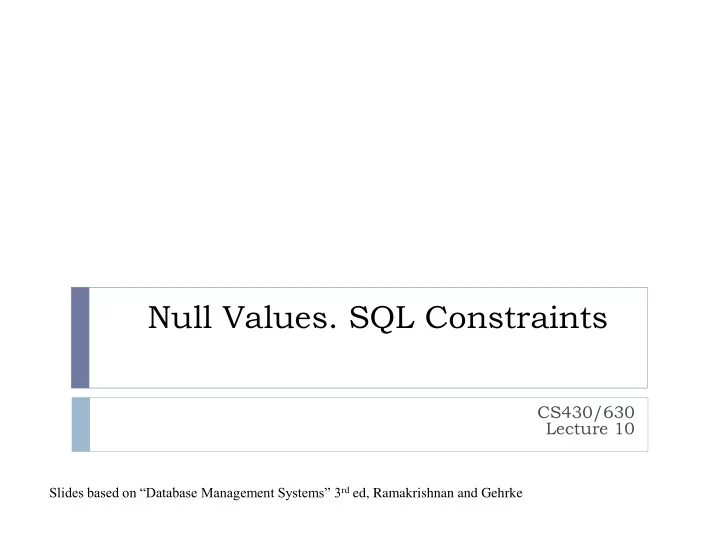

Null Values. SQL Constraints CS430/630 Lecture 10 Slides based on “Database Management Systems” 3 rd ed, Ramakrishnan and Gehrke
Null Values Field values in a tuple may sometimes be unknown : e.g., a rating has not been assigned, or a new column is added to the table inapplicable : e.g., CEO has no manager, single person has no spouse SQL provides a special value NULL for such situations Special operators IS NULL , IS NOT NULL SELECT * FROM Sailors WHERE rating IS NOT NULL Note: NULL must not be used as constant in expressions! A field can be declared as NOT NULL , means NULL values are not allowed (by default, PK fields are NOT NULL)
Dealing with Null Values The presence of NULL complicates some issues NULL op value has as result NULL (op is +,-,*,/) What does rating>8 evaluate to if rating is equal to NULL ? Answer: unknown 3-valued logic : true, false and unknown Recall that WHERE eliminates rows that don’t evaluate to true What about AND, OR and NOT connectives? unknown AND true = unknown unknown OR false = unknown NOT unknown = unknown Also, <NULL_value> = <NULL_value> is unknown!
Null Values and Aggregates The COUNT(*) result includes tuples with NULL COUNT(A) only counts tuples where value of attribute A is not NULL All other aggregates skip NULL values (if aggregate is on the field that is NULL) If all values are NULL on the aggregated field, the result of aggregate is also NULL (except COUNT which returns 0)
Null Values and Aggregates Following two queries DO NOT RETURN SAME RESULT if there are NULLs (in field name ): SELECT COUNT(*) FROM Sailors S SELECT COUNT(S.name) FROM Sailors S Following two queries DO NOT RETURN SAME RESULT if there are NULLs (in field rating ): SELECT COUNT(*) FROM Sailors S SELECT COUNT(*) FROM Sailors WHERE (rating>8) OR (rating <= 8)
Null Values and Duplicates Comparing two NULL values gives as result unknown But there are anomalies when checking for duplicates! NULL values are considered equal in this case! Two tuples are duplicates if they match in all non-NULL attributes Implications for DISTINCT, UNIQUE subqueries, set operations! Tuples with NULL in some group-by attributes placed in same group if all non-NULL group-by attributes match! DISTINCT: if multiple tuples have equal values in all non- NULL attributes only one of them is output
Outer Joins Include in join result non-matching tuples Result tuple padded with NULL values Variants FULL: non-matching tuples in both relations included in result LEFT: only non-matching tuples in left relation included in result RIGHT: only non-matching tuples in right relation included in result
Outer Joins Sailors Reserves sid sname rating age sid bid day 22 dustin 7 45.0 22 101 10/10/96 31 lubber 8 55.5 58 103 11/12/96 58 rusty 10 35.0 SELECT sid, sname, rating, age, bid, day FROM Sailors NATURAL LEFT OUTER JOIN Reserves sid sname rating age bid day 22 dustin 7 45.0 101 10/10/96 31 lubber 8 55.5 NULL NULL 58 rusty 10 35.0 103 11/12/96
Join Expressions SQL shorthands for expressions we already saw Cross Product: Sailors CROSS JOIN Reserves Condition Join: Sailors JOIN Reserves ON <condition> Natural Join: Sailors NATURAL JOIN Reserves Usage Example: SELECT * FROM Sailors JOIN Reserves ON Sailors.sid=Reserves.sid
Integrity Constraints (Review) An IC describes conditions that every legal instance of a relation must satisfy. Inserts/deletes/updates that violate IC’s are disallowed . Types of IC’s: domain constraints Field values must be of right type - always enforced primary key constraints foreign key constraints general constraints
Sample Schema
Enforcing Referential Integrity What should be done if an Enrolled tuple with a non-existent student id is inserted? Reject the insert! What should be done if a Students tuple is deleted? Delete all Enrolled tuples that refer to it Correct as far as IC is concerned, but data is lost! Disallow deletion of a Students tuple that is referred to More appropriate in practice Set sid in Enrolled tuples that refer to it to a default sid Or, set it to NULL 14
Referential Integrity in SQL SQL/92 and SQL:1999 support CREATE TABLE Enrolled all options on deletes and (sid CHAR (20 ) default ‘00’, updates. cid CHAR(20) , Default is NO ACTION grade CHAR (2), ( delete/update is rejected ) PRIMARY KEY (sid,cid), CASCADE (delete/update all FOREIGN KEY (sid) tuples that refer to REFERENCES Students (sid) deleted/updated tuple) ON DELETE SET DEFAULT SET NULL / SET DEFAULT (sets ON UPDATE CASCADE ) foreign key value of referencing tuple) 15
Complex Constraints: CHECK clause Useful when more general ICs than keys are involved CREATE TABLE Sailors ( sid INTEGER, Can use queries to express sname CHAR(10), constraint rating INTEGER, age REAL, PRIMARY KEY (sid), Constraints can be named CONSTRAINT RatingRange CHECK ( rating >= 1 Not checked if table is empty! AND rating <= 10 ) ) Standalone CHECK for single table only!
Complex Constraints: Assertions Number of boats plus number of sailors is < 100 Not associated with a particular table Constraint may apply to multiple tables! CREATE ASSERTION smallClub CHECK ( ( SELECT COUNT (S.sid) FROM Sailors S) + ( SELECT COUNT (B.bid) FROM Boats B) < 100 )
Recommend
More recommend